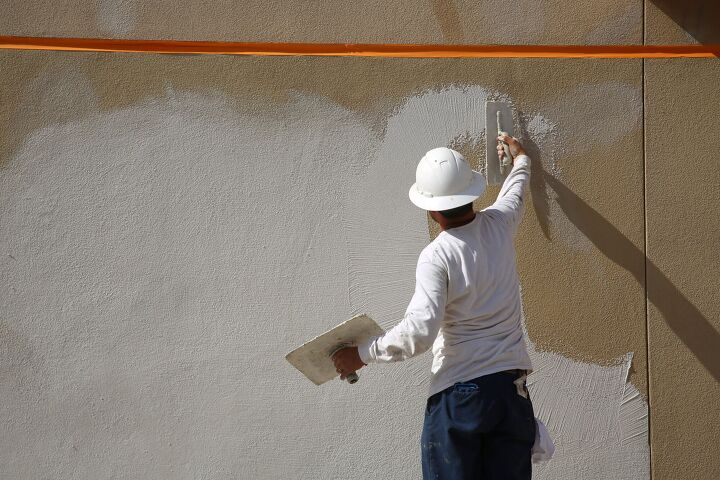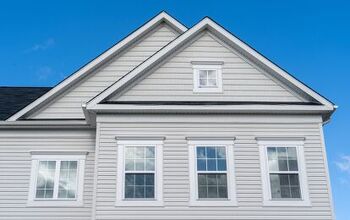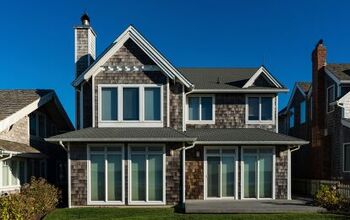Stucco Vs. Fiber Cement Siding: Which One Is Better?

The main job of your siding is to protect your home from the elements – particularly precipitation and the negative effects of excess moisture. However, in addition to practicality, your siding also serves an aesthetic purpose and can drastically impact the value of your home. With this in mind, your choice in siding should be based on aesthetics, maintenance needs, durability, environmental impact, installation, composition, and overall costs.
Whether you’re deciding to replace the siding on your home or prepping for new construction, you have many siding options to choose from. One of the most popular choices, and for good reason, is stucco. Though, fiber cement siding has been gaining popularity among homeowners in recent years.
These two options – stucco vs. fiber cement – offer some substantial differences that should be considered before you decide. With that said, let’s take a look at how these types of siding compare so you can make an informed decision for your home.
Do You Need Stucco Installation or Replacement?
Get free, zero-commitment quotes from pro contractors near you.

What is Stucco?
Although stucco may be an older siding technique, it has withstood the test of time. Made by mixing together Portland cement, sand, lime, and water, stucco is plaster-like substance that is applied over lath, or mesh, or directly over stone surfaces. It is applied with a hand trowel or sprayer and built up in coats, each of which are between 3/8” and 7/8” in depth. As an older technique that has been used for decades, stucco is often slightly more expensive – compared to brick and metal siding.
The greatest advantage that stucco offers is its durability, and fire-retardant properties. When properly applied, stucco can last on a home for 50 to 75 years. It is typically applied with a uniquely rough texture that gives a structure a very naturalistic appearance. There are also more unusual techniques, such as those that involve small stones, to create a distinct look. On the downside, stucco is vulnerable to moisture damage and cracking, requiring routine maintenance.
What is Fiber Cement Siding?
Fiber cement siding, on the other hand, is a more recent invention in the industry, often referred to “Hardie Board.” It is made with a mixture of water, Portland cement, wood pulp, and silica sand or fly ash. The 8 to 10% wood fiber is also for additional durability and flexibility. When all of these materials are combined, they create a strong bond that is nearly indestructible.
Although fiber cement siding may be slightly more affordable than stucco, it is more expensive than conventional siding options, like vinyl. However, fiber cement comes with a number of advantages, including low maintenance demands and longevity. When used as exterior siding, fiber cement comes in a number of different forms, such as shingles, long boards, lap siding, and panels that are similar to vertical board and batten.
Not to mention, fiber cement siding is water- and pest-resistant – but how does it compare to stucco?
Stucco vs. Fiber Cement Siding
When you compare stucco to fiber cement siding, it’s easy to see the significant differences. Here are some things to keep in mind:
Composition
Although fiber cement and stucco are both made of manmade materials, fiber cement tends to resist moisture better. This helps it last longer than stucco and requires less frequent repairs. Stucco is made with Portland cement, water, sand, and lime, forming an earthy plaster-like substance. Applied in coats, when stucco is completely hardened is has a warm, clay-like appearance that gives it its durability.
Fiber cement siding, on the other hand, is made of Portland cement, wood pulp, and fly ash or silica sand – a mixture that is virtually unbreakable. Oftentimes, homeowners who want exceptional curb appeal that is long-lasting and requires low maintenance opt for fiber cement siding.
Installation
Both stucco and fiber cement require skilled installation techniques, meaning you should hire a professional who knows what they’re doing. Stucco is always handcrafted based on the home, which yields a personalized look and distinctive artistic aesthetic. Even the most skilled professionals can’t prevent stucco from cracking, but improper installation can lead to early stucco failure.
Fiber cement siding requires a qualified contractor that adheres in rigorous installation procedures, best practices, and technical specifications. Before Hardie siding can be installed, it’s recommended to remove the old siding. While this takes extra time and labor, it provides long-lasting results.
Durability
Durability is another important factor to consider when you’re updating your home’s siding. Stucco is durable, and resistant to both fire and termites. However, it performs best in dry, hot, desert-like environments and does not do well in areas that experience excessive moisture or heavy rain. If installed in moist, rainy, or snowy areas of the country, it’s highly likely that the stucco will crack and require frequent repairs to prevent moisture damage.
Whereas, fiber cement siding is designed to shed water. It resists moisture without wearing out or cracking, which may be this siding’s greatest advantage. Fiber cement siding also resists mold, fire, rot, insects, woodpeckers, and impact. If you live somewhere that is notorious for extreme weather and your home requires strong impact resistance, fiber cement siding is the ideal choice.
Aesthetics
Curb appeal and architectural style that are customized to your needs are also important factors to consider when replacing siding. Of course, like anything, “beauty is in the eye of the beholder,” and if you love the look of stucco, nothing else will be a worthy substitute. However, if you want the look of stucco without the complicated maintenance, fiber cement is a great choice!
Eco-Friendliness
Although both stucco and fiber cement are eco-friendly choices for your home’s siding, fiber cement siding is the more sustainable option of the two. Stucco’s inability to resist water can make it a hazard to your indoor air quality. Homeowners with allergies may want to consider fiber cement siding instead. Additionally, the frequent repairs that stucco requires means that more trash ends up in the landfill.
Fiber cement siding, on the other hand, is long-lasting, uses fewer resources to install, and is replaced far less often than stucco. This means that fiber cement has a smaller carbon footprint and is, therefore, the greener choice of the two.
Maintenance
When you compare the two, stucco and fiber cement require very different levels of maintenance. Since stucco is prone to weather damage, it requires frequent inspections. When water gets trapped in stucco it produces white, powdery patches that ruin the aesthetic appeal of the siding and can result in cracking.
Moisture can also penetrate behind the stucco, causing hidden rot. To prevent costly damage down the line, holes and cracks in stucco must be repaired quickly. Meanwhile, since fiber cement is resistant to moisture, insects, weather, peeling, and fading, it requires less maintenance. All fiber cement siding needs is a gentle cleaning once a year with a mild detergent, water and a soft bristle brush.
Do You Need Stucco Installation or Replacement?
Get free, zero-commitment quotes from pro contractors near you.

Cost
When replacing siding, material and installation costs, in addition to future maintenance expenses should all be considered. Since stucco is a labor-intensive process, this is reflected in the overall cost. Not to mention, this type of siding almost always produces additional expenses for maintenance and repairs.
| Siding Type | Average Cost |
| Stucco | $4.18 per square foot |
| Fiber Cement | $2.31 to $2.75 per square foot |
The average cost to install stucco is $4.18 per square foot, for materials and labor. Materials are more expensive and expert installation is crucial. If properly maintained, stucco can last 75 years or more, which puts its average cost per square foot per year of expected life at 7.5 cents.
In most cases, fiber cement siding costs less to install than stucco. However, its’ most impressive value is displayed in the considerably lower maintenance requirements and longevity of fiber cement. With this in mind, fiber cement siding gives you the greatest return on your investment when compared to stucco. The average cost to install fiber cement siding is between $2.31 and $2.75 per square foot for labor and materials.

Jessica considers herself a home improvement and design enthusiast. She grew up surrounded by constant home improvement projects and owes most of what she knows to helping her dad renovate her childhood home. Being a Los Angeles resident, Jessica spends a lot of her time looking for her next DIY project and sharing her love for home design.
More by Jessica Stone



























